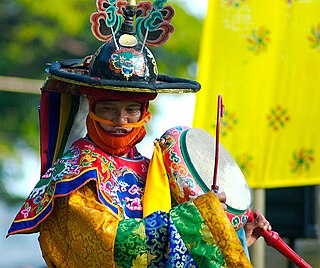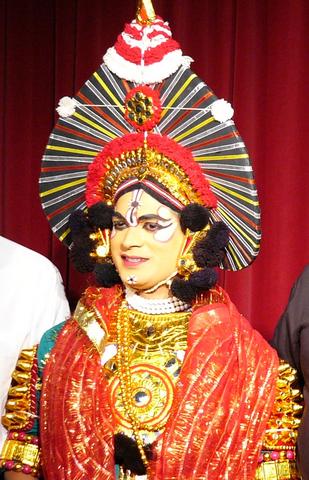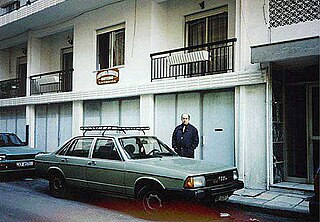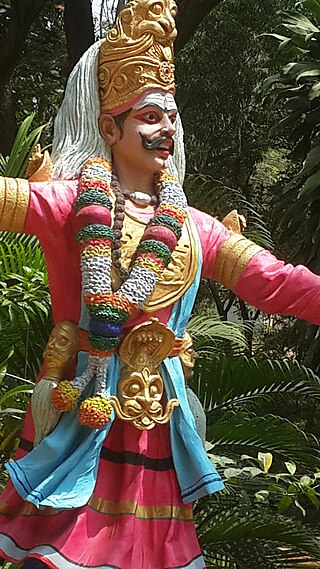
Yakshagana is a traditional theatre, developed in Dakshina Kannada, Udupi, Uttara Kannada, Shimoga and western parts of Chikmagalur districts, in the state of Karnataka and in Kasaragod district in Kerala that combines dance, music, dialogue, costume, make-up, and stage techniques with a unique style and form. It is believed to have evolved from pre-classical music and theatre during the period of the Bhakti movement. It is sometimes simply called "Aata" or āṭa. This theatre style is mainly found in coastal regions of Karnataka in various forms. Towards the south from Dakshina Kannada to Kasaragod of Tulu Nadu region, the form of Yakshagana is called Thenku thittu and towards the north from Udupi up to Uttara Kannada it is called Badaga thittu. Both of these forms are equally played all over the region. Yakshagana is traditionally presented from dusk to dawn. Its stories are drawn from Ramayana, Mahabharata, Bhagavata and other epics from both Hindu and Jain and other ancient Indic traditions.

Folk art covers all forms of visual art made in the context of folk culture. Definitions vary, but generally the objects have practical utility of some kind, rather than being exclusively decorative. The makers of folk art are typically trained within a popular tradition, rather than in the fine art tradition of the culture. There is often overlap, or contested ground with 'naive art'. "Folk art" is not used in regard to traditional societies where ethnographic art continue to be made.

The cham dance is a lively masked and costumed dance associated with some sects of Tibetan Buddhism and Buddhist festivals. The dance is accompanied by music played by monks using traditional Tibetan musical instruments. The dances often offer moral instruction relating to karuṇā (compassion) for sentient beings and are held to bring merit to all who perceive them.

Komal Kothari (1929–2004) was an Indian folklorist and ethnomusicologist. Komal Kothari had devoted his life to investigation and documentation of folk traditions of western Rajasthan. Kothari received the honour of Padma Shri and Padma Bhushan from the Government of India. Komal Kothari painstakingly worked to preserve the cultural memory and made numerous recordings of folk music. He studied Langa and Manganiyar communities of folk musicians of Thar desert. Komal Kothari was not only a scholar but also a man of action. He co-founded Rupayan Sansthan - Rajasthan Institute of Folklore, in 1960 in the village of Borunda. The institution houses a repository of recordings by Kothari and works to collect, preserve, and disseminate the oral traditions of Rajasthan. Kothari was co-editor of the journal Lok Sanskriti, a journal based on the theme of folk culture. Besides, Kothari arranged international performances of folk artists from Rajasthan in several countries. His monograph on Langas, a folk-musician caste in Rajasthan, was enlivened by an accompanying album of recordings of twelve folk songs sung by Langa artistes. His understanding of desert culture and its connections with ecology endeared him to the environmentalists. He planned a museum based on the ecology of the broom’, to show the technical use of specific types of desert grass for specific purposes. His vision was actualised in the form of Arna Jharna - The Thar Desert Museum of Rajasthan in Borunda, near Jodhpur. Kothari was a scholar of patterns of culture and his expertise enriched both folklore studies and history.

National Museum of Folk Architecture and Folkways of Ukraine, is a 133.5 hectare open-air museum located at 1 Akademika Tronka Street, in the Pyrohiv neighbourhood of Holosiivskyi District, Kyiv, Ukraine. An architectural and landscape complex representing the major historical and ethnographic regions of Ukraine, it is dedicated to the preservation and study of regional Ukrainian folkways.
The Center for Folklife & Cultural Heritage (CFCH) is one of three cultural centers within the Smithsonian Institution in the United States. Its motto is "culture of, by, and for the people", and it aims to encourage understanding and cultural sustainability through research, education, and community engagement. The CFCH contains (numerically) the largest collection in the Smithsonian, but is not fully open to the public. Its budget comes primarily from grants, trust monies, federal government appropriations, and gifts, with a small percentage coming from the main Smithsonian budget.

Ivan Honchar Museum is a museum in Kyiv, Ukraine showcasing the culture of Ukraine and preserving Ukrainian folk art.

Karnataka, a southern state in India, has a distinct art style and culture informed by a long history of diverse linguistic and religious ethnicities. Apart from Kannadigas, Karnataka is home to Tuluvas, who also consider themselves as Kannadigas. Minor populations of Tibetan Buddhists, Siddhi tribes, and a few other ethnic groups also live in Karnataka. The traditional folk arts are major theatrical forms in coastal Karnataka. Contemporary theatre culture in Karnataka is one of the most vibrant in India, with organizations like Ninasam, Ranga Shankara, and Rangayana on foundations laid by the Gubbi Veeranna Nataka Company. Veeragase, Kamsale, and Dollu Kunitha are popular dance forms. Bharatanatya also enjoys wide patronage in Karnataka.

Karnataka has a variety of traditional arts, including folk dance and puppetry.

The Polish Museum of America is located in West Town, in what had been the historical Polish Downtown neighborhood of Chicago. It is home to numerous Polish artifacts, artwork, and embroidered folk costumes in its growing collection. Founded in 1935, it is one of the oldest ethnic museums in the United States and a Core Member of the Chicago Cultural Alliance, a consortium of 25 ethnic museums and cultural centers in Chicago.

The chande is a drum used in the traditional and classical music of South India and particularly in Yakshagana theatre art of Karnataka. It follows the Yakshagana Tala system. The rhythms are based on pre-classical music forms that Karnataka Sangeta and Hindustani Sangeetha are based on. There are different varieties of this instrument; two major varieties being the Badagu Thittu Chande and the Thenku Thittu Chande. The latter can also be spelled chenda and is used exclusively in the art forms of southern coastal Karnataka and Kerala. This article deals with Badagu Thittu Chande, used exclusively in Yakshagana of Karnataka. The chande used in Badagu Thittu is structurally and acoustically different from the chenda used in Kerala.

Old Belarusian History Museum is a museum in Minsk, Belarus.
Pravina Shukla is an American folklorist who is Provost Professor of Folklore at Indiana University Bloomington and serves as an adjunct faculty member in the Department of Anthropology, Department of American Studies, the Dhar India Studies Program, and the Center for Latin American and Caribbean Studies. She is also a consulting curator at the Mathers Museum of World Cultures.
Bharatiya Lok Kala Mandal is a museum based in Udaipur in Rajasthan state in India engaged in studying folk art, culture, songs and festivals of Rajasthan, Gujarat and Madhya Pradesh and to popularise and propagate folk arts, folk dances and folk literature. It was founded by Padam Shri Late Devi Lal Samar in the year 1952. The institution has a museum that exhibits collection of folk articles from Rajasthan like rural-dresses, ornaments, puppets, masks, dolls, folk musical instruments, folk deities and paintings. There is puppet theater (Kathputli) too where puppet shows are held at regular intervals.

The Hadzilia Folklore and Ethnological Museum is a private museum in the northern Greek city of Serres, a collection built up over twenty years, which opened in June 1998.
P.R. Thippeswamy was an artist and folklorist of Karnataka. He was popularly known as PRT. He was instrumental in establishment of the "Folklore Museum" in Mysore in 1968. He was also the first curator of the museum. The folklore museum contains Representative collection of arts and crafts from all over Karnataka. P.R.Thippeswamy brought material from all over Karnataka to increase the collection. One of the displays in the museum is the "Ink" prepared locally by the great grandfather of the late P.R.Thippeswamy at Dodderi village of Chitradurga District 200 years ago.
Family folklore is the branch of folkloristics concerned with the study and use of folklore and traditional culture transmitted within an individual family group. This includes craft goods produced by family members or memorabilia that have been saved as reminders of family events. It includes family photos, photo albums, along with bundles of other pages held for posterity such as certificates, letters, journals, notes, and shopping lists. Family sayings and stories which recount true events are retold as a means of maintaining a common family identity. Family customs are performed, modified, sometimes forgotten, created or resurrected with great frequency. Each time the result is to define and solidify the perception of the family as unique.

Janapada Loka, is a folk museum that has an exclusive display of the village folk arts of Karnataka. It is under the aegis of the Karnataka Janapada Parishat. Loka Mahal, a wing in the museum has a display of 5,000 folk artifacts. It is situated in Ramanagara, Ramanagara district in the Indian state of Karnataka, on the Bangalore-Mysore highway, 53 kilometres (33 mi) to the south of Bangalore.













